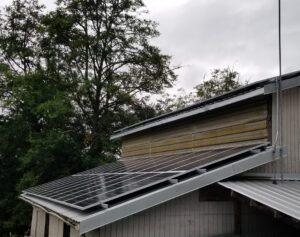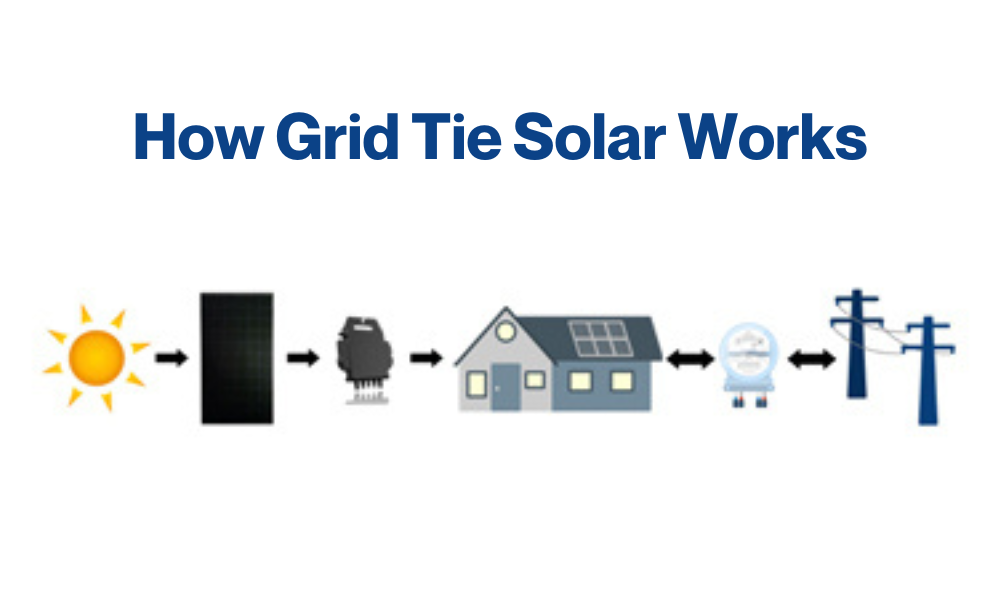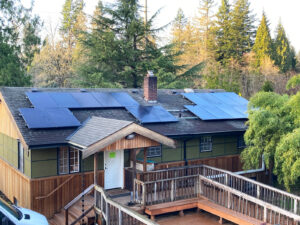How Grid Tie Solar Works
How Grid Tie Solar Works

Grid tie solar simply means your solar electric system is connected to, and relies on, your utility grid as an essential system component. Grid tie solar is the most common type of solar power system in the U.S.
A grid tie solar system is an array of solar panels installed and connected to your home’s electrical service. The solar panels harvest and turn sunlight into direct current (DC) which flows to a string inverter or multiple micro inverters that convert the DC electricity into household alternating current (AC).
During the day, the converted solar power runs through your building’s electrical panel and is first used to power any immediate electrical needs in your home or business. When those needs are met, any additional electricity is sent out to the grid through your utility meter. What happens next depends on where you live.
In many states, including Washington, “net metering” lets you get the most out of your grid tied solar system.
Net metering means your utility tracks any excess energy produced by your solar array and sent out to the grid as credits on your account. For each kwh you send to the grid you get a 1 kwh credit to use later. Your utility then bills you for the “net” amount of energy. If you made more energy than you used the credits carry over to the next billing cycle.
Outside Washington utilities may have different rules regarding how solar energy is compensated. In some areas, utilities give a set kWh price for excess production sent to the grid. This may or may not be equal to the amount charged per kWh at a later time. There is wide variation across the country, and even within state lines in some areas.
What Happens When the Sun Isn’t Shining?
Solar panels only produce electricity when the sun is shining, but we need electricity all the time. So, what happens at night and on cloudy days?
This is where the benefits of net metering kick in. Remember that extra power your solar energy system made that was sent out to the grid for credits? Well, when your solar panels aren’t producing power and you need to buy electricity from your utility provider, they immediately apply those credits to what you owe them, and then just bill you for any balance, or the “net” amount of power. If over your billing period you don’t use up all your net metering credits, they will roll over to the next billing period for future use.
Proper Sizing of Grid Tie Solar is Important
If you’re looking to offset all or a large portion of your energy use with solar, proper sizing of your grid tie solar system is critical. When calculating the size of system needed, it’s best to start with data about your most recent 12 months of electricity use. By using your annual average consumption, not only is nighttime power use taken into account, but seasonal variations in power use are as well. The solar power system size is then calculated to, on average, cover your yearly electricity use.
Once you know what size of grid tie solar system you need to cover your entire electric bill, how many solar panels you will need can be determined. After that whether or not all the solar panels will fit on your roof needs to be calculated, as roof space if frequently a constraining factor. Then finally, how much you want to invest in solar is factored in to find the right size of solar system to meet your specific goals.
What Happens When Utility Power Goes Out?
Grid tie solar systems are dependent on utility power to operate. Why? Strictly for safety of electrical workers.
If a grid tie solar system continued to run when the utility power went out, any excess power produced and sent out to the grid would put utility workers in danger of electrocution. For that reason, all grid tie solar inverters must receive power from the grid to function. Once the grid goes down, so does your inverter(s). Which means that even though the solar panels are still making power, the power becomes unavailable for use until utility power is restored.
Want all the benefits of grid tie solar plus emergency power when the grid goes down?
Grid-tie solar systems are extremely popular because they guarantee your investment.
Yes, you read that correctly Solar is a guaranteed investments. As long as your solar power system is functional, it will eventually pay for itself. Heres how:
- First, you’ll see savings on your immediate electrical costs as the solar is activated and starts producing electricity.
- Second, you are protected against increasing utility prices for the life of the system. Generally, you can expect at least 25-30 years out of your system. And there are many systems still working that are 40+ years old!
- Third, solar increases your property’s value and resale appeal – as soon as you have solar, this “solar premium” takes effect.
- Finally, grid-tied systems are eligible for a 26% federal income/investment tax credit, and in Washington State they are also exempt from sales tax. This applies to the total cost of the installation – not just the equipment! Read more about the Solar Incentives.
Reputable solar installers excel at determining how to best take advantage of the benefits of solar, while navigating a complex utility landscape.
Fire Mountain Solar has the experience and expertise to help you take advantage of all the benefits solar no matter where you live. Whether you want to DIY solar, or you live in Washington state and are looking for a full service installation project, we are here to answer questions, make recommendations, and be a resource for you—before, during, and after the completion of your project.
Read Related Articles:


